Competitive balance (CB) is one of the most researched concepts in the sports economics literature. CB relates to the overall balance of a sports leagues or championships, i.e. the closeness of all participants. Empirical studies suggest higher degrees of uncertainty contribute to greater interest in sporting activities, increased attendances at matches and larger television audiences. As such, sporting bodies across a range of sports have implemented policies with the aim of increasing CB across their leagues. One strategy employed by the NBA to promote CB is linked to the draft system.
The NBA draft is an imperfect system, which rewards the teams with the worst win percentages with a greater opportunity of obtaining a high draft picks. The markets for NBA players are similar to other markets insofar as individuals and firms respond to incentives. As such, in the NBA teams are incentivised to ‘tank’ i.e. intentionally losing games in order to increase their chances of receiving the number 1 pick in the NBA draft. Tanking is particularly relevant for the NBA where one player can transform a team with a losing record to championship contenders e.g. previous Number One draft picks such as Tim Duncan or LeBron James have made their respective teams a championship contender for more than a decade.
 The Philadelphia 76ers
The Philadelphia 76ers
The NBA have approved a new draft system for 2019 with the three worst teams in the league each having the same chance—16 percent—at the top overall pick. Under the previous system, the team with the worst record in the league had a 25 percent chance at the top spot. The new system also smooths out the odds across the board so that the teams ranked from 4 to 14 get a slightly better chance at the top pick. These measures have been implemented in an attempt to reduce the incentive for teams to tank. However, given the imperfect nature of the draft system, these new measures are unlikely to provide an effective deterrent for teams engaging in tanking behaviour.
 RSS Feed
RSS Feed